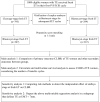The embryo stage at fresh ET does not affect the cumulative live birth rate in women with a thin endometrium: a retrospective matched-controlled cohort study
- PMID: 39722813
- PMCID: PMC11668585
- DOI: 10.3389/fendo.2024.1448138
The embryo stage at fresh ET does not affect the cumulative live birth rate in women with a thin endometrium: a retrospective matched-controlled cohort study
Abstract
Background: The blastocyst-stage embryo has been considered more advantageous for increasing the cumulative live birth rate (CLBR) at fresh embryo transfer (ET) compared to the cleavage-stage embryo. However, it remains uncertain whether this advantage extends to specialized subpopulations, such as women with thin endometrium (TE), who are characteristic of impaired endometrial receptivity. Thus, this study aims to evaluate the difference in the CLBR between cleavage-stage and blastocyst-stage embryos at fresh ET specifically in women with TE.
Methods: A retrospective cohort comprising 1089 women from three centers, ranging from September 2017 to January 2022, was established. These women were diagnosed with TE (defined as endometrium thickness <= 8 mm) and underwent their first fresh ET. To create a comparable cohort between the cleavage and blastocyst groups while adjusting for key covariates, the propensity score matching (PSM) method was employed. The primary outcome assessed was the CLBR per woman. Both cohorts underwent Kaplan-Meier analysis, Cox proportional hazard models, cumulative incidence function (CIF) curve analysis, and Fine-Grey competing risk models to ascertain the impact of embryo stage at fresh ET on CLBR. Additionally, a sensitivity analysis was conducted within a subgroup defining thin endometrium as an endometrium thickness (EMT) < 7 mm.
Results: In the matched cohort after PSM, the CLBR was comparable between groups (p=0.331). However, the cleavage-stage fresh ET was associated with an elevated risk of low birth weight (LBW) (p=0.005) and small for gestational age (SGA) (p=0.037). Kaplan-Meier analysis showed that the median number of embryo transfer cycles was 2 in the cleavage group and 3 in the blastocyst group. The CLBR for the cleavage group reached 78.1%, while the blastocyst group reached 60.0% after 5 cycles of embryo transfers (log-rank test, p=0.09). A multivariable Cox proportional hazard model indicated no significant association between the embryo stage at fresh ET and CLBR (HR=0.80, 95% CI=0.60-1.07). The CIF curve and Fine-Grey competing risk models demonstrated similar results. These analyses were repeated in the original cohort before PSM and in the subgroup with EMT < 7 mm, and the results remained robust.
Conclusion: For TE women receiving fresh ET, the choice between the cleavage-stage embryo and the blastocyst-stage embryo yields comparable CLBR. However, selecting the cleavage-stage embryo is associated with increased risks of LBW and SGA births.
Keywords: blastocyst-stage; cleavage-stage; cumulative live birth rate; fresh ET; thin endometrium.
Copyright © 2024 Han, Chen, Zhang, Song, Xu, Li, Guo and Sun.
Conflict of interest statement
The authors declare that the research was conducted in the absence of any commercial or financial relationships that could be construed as a potential conflict of interest.
Figures



References
-
- The European IVF Monitoring Consortium (EIM) for the European Society of Human Reproduction and Embryology (ESHRE) Gliozheni O, Hambartsoumian E, Strohmer H, Petrovskaya E, Tishkevich O, et al. . ART in Europe, 2019: results generated from European registries by ESHRE. Hum Reprod. (2023) 38:2321–38. doi: 10.1093/humrep/dead197 - DOI
-
- Cornelisse S, Fleischer K, Arends B, Brink-van Der Vlugt JJ, De Bruin JP, Curfs MHJM, et al. . O-005 The ToF-study - comparing the cumulative live birth rate of blastocyst-stage versus cleavage-stage embryo transfers in good prognosis IVF patients: a multicenter randomized controlled trial. Hum Reprod. (2023) 38:i2–i3. doi: 10.1093/humrep/dead093.005 - DOI
MeSH terms
LinkOut - more resources
Full Text Sources
Miscellaneous

